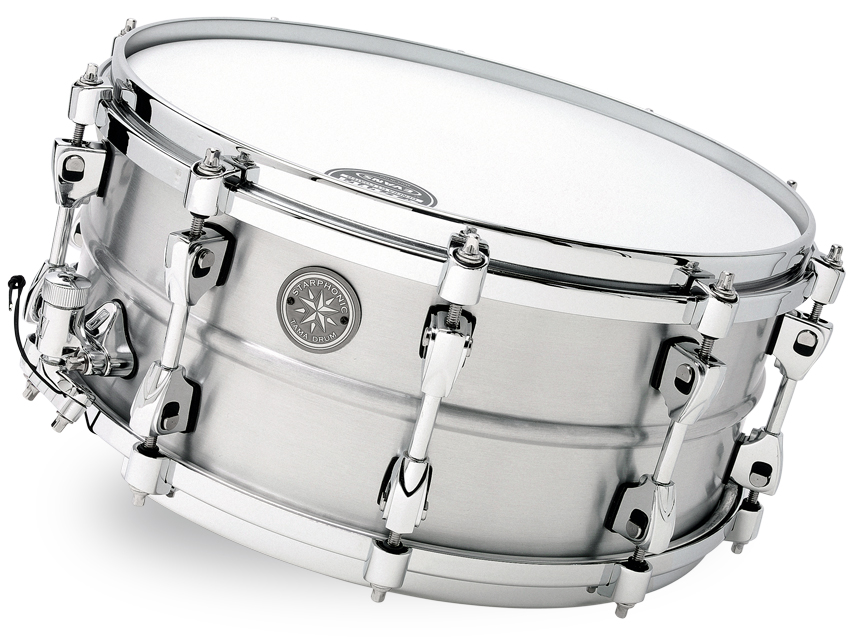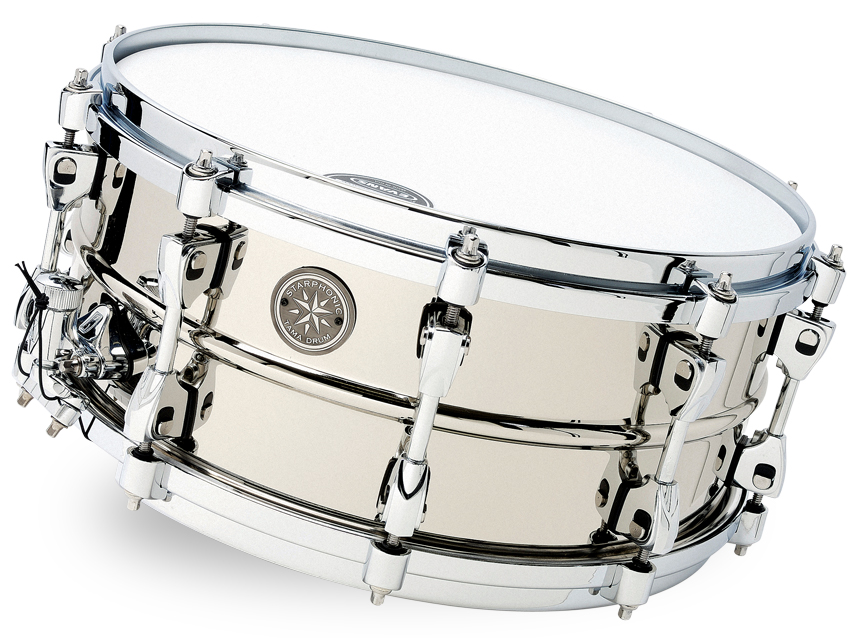MusicRadar Verdict
Tama clearly set out to build serious high-end snare drums and what it has achieved is close to perfection. As with all high-end gear, the price tags are reassuringly expensive. To our ears, though, they represent good value.
Pros
- +
Versatile, beautifully made and a pleasure to play. No crackles, buzzes or dead spots.
Cons
- -
We didn't get to try the two wooden models!
MusicRadar's got your back

Tama Starphonic Aluminium Snare

Tama Starphonic Brass Snare
Starphonic snares were devised in the wake of the success of Tama's Warlord collection of snare drums. While the Warlord snares were universally praised for their sound and uncompromising quality, their looks placed them very firmly in metal Lord Of The Rings territory.
The new Starphonic drums are Tama's attempt to create a set of modern classic snares with more conventional looks. A quartet of Starphonic snares was launched at the summer NAMM show consisting of brass, aluminium, maple and bubinga drums, with each model only available in one 14"x6" size.
Of the four drums, we were sent the brass and aluminium-shelled examples.
Build
In a nod to classic snare design, the drums feature a single central horizontal bead. Both share an identical 1.2mm shell thickness. The aluminium shell is spun, therefore seamless, while the brass drum is cut from a single sheet of brass and bent into shape before being nickel coated.

The shell of the aluminium drum has been simply brushed to a satin lustre. In contrast, the brass drum is polished to a liquid-like gloss. The nickel coating mutes the typical hues of brass to the extent that the shell is only slightly warmer in colour than the chrome-plated lugs and hoops.
Tama is renowned for its engineering prowess, so it's no surprise to find the Starphonic drums bristling with technical innovations. Most noticeable are the Grooved Hoops which have been developed exclusively for the Starphonic range.
"It's the kind of drum that would bite the bass player's arse when he wasn't looking"
Grooved Hoops differ at a fundamental level from normal hoops as they are completely undrilled. At the point where the hoop is angled to flow over the edge of the drum, the fold dips down towards the inside of the shell, forming a groove.
Tama's Claw Hooks - a chunky update of those found on vintage snares - do as their name suggests and hook over the side of the hoops, locating firmly in the groove. The tension rods are fed through the Claw Hooks, leaving the hoops untouched by a drill.
The absence of drill holes makes for remarkably strong hoops that, though they are only flanged, have the feel of die-cast hoops. The top of the Grooved Hoops differs as well; rather than curving away from the drum they do the opposite and turn inwards. According to Tama, this enhances the natural tone of the drum. This shape is defi nitely kinder to sticks, so your Pro-Marks won't be reduced to firewood at quite the same rate.
Partnering the Claw Hooks are Tama's Freedom Lugs, two sets of single point lugs that are connected by a length of tubing. The tension rods thread into a bar in each lug which 'floats' in a hollow cavity. This means heads can be changed with only a minimal amount of tension being dialled out of the rods.
Once the Claw Hooks have been eased out of the Grooved Hoops the rods can be tilted away from the drum, allowing the hoop to be lifted clear. Leaving the rods attached to the drum means there's no chance of spilling them from the hoop during a head change.
Hands on
Unsurprisingly, the brass drum is heavier than the aluminium model. The choice of metal and its weight translates into a bright, hard-edged sound. To say it's loud is an understatement, as strokes seem to end in detonations. Any energy directed towards the drum appears to be doubled on impact and then flung back with four times the force.
Even softer hitters will probably find that it dominates a loud backline. It's the kind of drum that would bite the bass player's arse when he wasn't looking.
By comparison the aluminium drum is house trained, but still an absolute belter. Aluminium makes for a naturally drier sound, but if the drum is slightly less cutting it makes up for it with a huge, stadium-sized note. Crisp attack leads to a fat, gutsy core - the classic rock snare sound.
There's more to both drums than sheer power. The degree of sensitivity and spectrum of responses is nothing short of exquisite. That said, if you rimshot either on a regular basis you'll need to learn to lip-read…
“Built from the same sacred stash of NOS silicon transistors and germanium diodes, giving it the soul – and snarl – of the original”: An octave-fuzz cult classic returns as Jam Pedals resurrects the Octaurus
What’s the buzz? Meet Yellowjacket, Cherry Audio's recreation of EDP’s trend-setting Wasp from 1978
“A fabulous trip through all eight songs by 24 wonderful artists and remixers... way beyond anything I could have hoped for”: Robert Smith announces new Cure remix album









